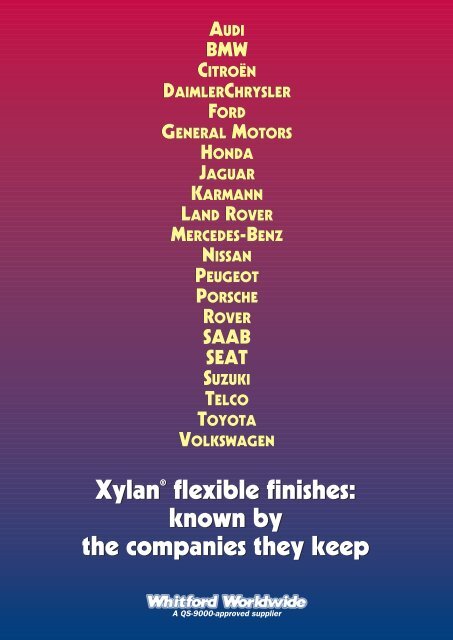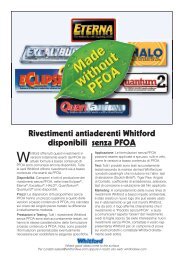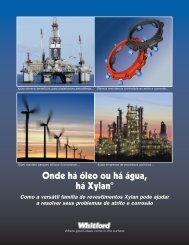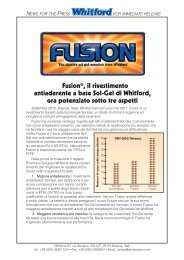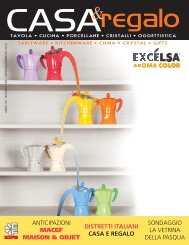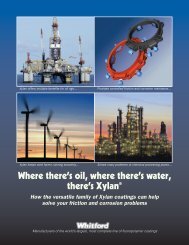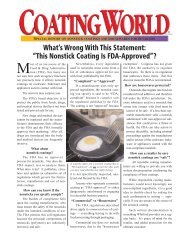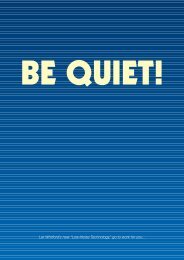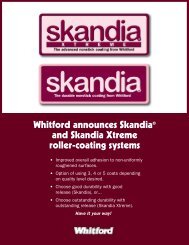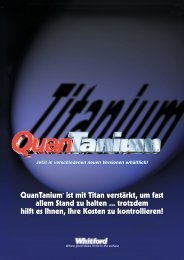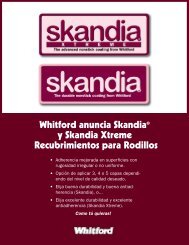Flexible Finishes
Flexible Finishes
Flexible Finishes
You also want an ePaper? Increase the reach of your titles
YUMPU automatically turns print PDFs into web optimized ePapers that Google loves.
Xylan ®<br />
Xylan ®<br />
AUDI<br />
BMW<br />
CITROËN<br />
DAIMLERCHRYSLER<br />
FORD<br />
GENERAL MOTORS<br />
HONDA<br />
JAGUAR<br />
KARMANN<br />
LAND ROVER<br />
MERCEDES-BENZ<br />
NISSAN<br />
PEUGEOT<br />
PORSCHE<br />
ROVER<br />
SAAB<br />
SEAT<br />
SUZUKI<br />
TELCO<br />
TOYOTA<br />
VOLKSWAGEN<br />
flexible finishes:<br />
known by<br />
the companies they keep<br />
A QS-9000-approved supplier
Xylan: coatings born out of the<br />
problems of the automotive industry<br />
Xylan is a product of Whitford Worldwide,<br />
makers of the largest, most complete line of fluoropolymer<br />
coatings in the world.<br />
Some companies develop products in the<br />
abstract — and then bend problems to fit the<br />
products. Whitford takes the opposite point of<br />
view. We believe that the way to a better product<br />
is to start with a specific problem, then create<br />
a product designed to solve it.<br />
Xylan solved a glass-run abrasion<br />
problem for the Honda Civic.<br />
This approach<br />
led to<br />
automotive<br />
manufacturers<br />
looking<br />
for an alternative<br />
to traditionalmethods<br />
of post-<br />
treating elastomeric seals and mouldings.<br />
These traditional treatments involve the use of<br />
polyamide and polyester flocking agents, silicone<br />
solutions, fine particle chalks and specialist<br />
greases to reduce friction, suppress noise,<br />
avoid sticking and protect against weathering.<br />
Whitford’s research and development teams<br />
created a range of products to provide superior<br />
alternatives to these methods, often working<br />
hand in hand with sealing-system manufacturers<br />
and automotive companies. The end result<br />
is Xylan, a comprehensive range of coating<br />
solutions for automotive sealing systems which<br />
owe their unique effectiveness to a number of<br />
revolutionary technological advances pioneered<br />
by Whitford.<br />
Another benefit of the new Xylan coatings:<br />
rapid, yet effective processing techniques<br />
which have been developed in close cooperation<br />
with sealing-system manufacturers.<br />
Who’s using Xylan?<br />
Companies that are successfully using<br />
Xylan-coated sealing systems include:<br />
• Audi • BMW<br />
• Citroën • DaimlerChrysler<br />
• Ford • General Motors<br />
• Honda • Jaguar<br />
• Karmann • Land Rover<br />
• Mercedes-Benz • Nissan<br />
• Peugeot • Porsche<br />
• Rover • SAAB<br />
• SEAT • Suzuki<br />
• Telco • Toyota<br />
• Volkswagen<br />
QS-9000:<br />
The Automotive Seal of Quality<br />
Whitford is one of a select group of companies<br />
who have achieved the coveted status of<br />
being a QS-9000 rated supplier<br />
to the automotive industry.<br />
This commitment to the<br />
most exacting standards<br />
is maintained by quality<br />
assurance teams at each of<br />
Whitford’s worldwide facilities.<br />
Their sole task is to ensure that, as a supplier<br />
already rated to BS EN ISO 9001:1994, Certificate<br />
No. FM24177 and EAQF94 standards,<br />
continual improvement in quality is achieved.<br />
The popular Land<br />
Rover “Discovery”<br />
uses Xylan on the<br />
rear-door seal to<br />
provide excellent<br />
freeze-release as<br />
well as outstanding<br />
resistance to<br />
abrasion.
Xylan coatings and the many benefits<br />
they provide for sealing systems<br />
Xylan coatings offer a complete range of • Outstanding release properties.<br />
outstanding benefits to solve the problems of • Good aesthetic properties, including<br />
automotive sealing systems:<br />
clear coatings.<br />
• Low friction.<br />
• Colour-coordinated coatings (many<br />
• Excellent resistance to abrasion.<br />
colours to match the interior trim).<br />
• Elimination of noise from seal micromove- • Improved weathering and chemical resistment<br />
against the car body and glass.<br />
ance of sealing system compounds.<br />
• Soft touch (a velvet aspect<br />
for the cosmetic limbs of<br />
internal seals to match<br />
the interior trim velour).<br />
All Xylan coatings also provide<br />
significant benefits in processing:<br />
• Simple, easy-to-control,<br />
monitored applications.<br />
• Less likelihood of contamination<br />
than with alternative<br />
technologies.<br />
Volkswagen specified Xylan for application to the “A” pillar seal to reduce • Extremely cost-effective.<br />
noise generated through wind resistance in the Golf.<br />
Xylan works, whatever the application<br />
Xylan coating materials have proved highly<br />
successful in many different automotive applications.<br />
In glass-run channels, for instance,<br />
Xylan’s remarkable abrasion resistance<br />
ensures long-lasting, smooth, silent window<br />
operation combined with consistently low levels<br />
of friction. When used on boot<br />
(trunk) seals, this versatile material<br />
provides excellent release even in<br />
the most adverse conditions.<br />
In addition to excellent release,<br />
Xylan provides outstanding appearance,<br />
door-slam resistance and<br />
protection against weathering to<br />
main door seals, body seals and<br />
drip rails. Xylan greatly enhances<br />
the weather resistance and appearance<br />
of door pillars and exterior<br />
window seals. Xylan coatings also<br />
combat the effect of “stick-slip”, thus reducing<br />
squeak and noise associated with the micromovement<br />
of seals against body panels and<br />
glass.<br />
Variety of Substrates<br />
Xylan coatings are not limited to applica-<br />
The Rover 25 uses Xylan on its glass-run channels to reduce friction and<br />
resist abrasion, making operation of windows quiet and effortless.
tions with EPDM. They<br />
have also been successfully<br />
applied to NBR, PVC,<br />
ASA, acrylics, ABS and<br />
polyester, sometimes in<br />
combination with Whitfordprovided<br />
or approved<br />
primer systems.<br />
In anticipation of new<br />
market trends, Whitford<br />
has carried out extensive<br />
development in the formulation<br />
of Xylan coating<br />
variations for specific use<br />
on TPE (TPV/TPO) substrates.<br />
Pretreatment<br />
In many cases, a clean,<br />
contamination-free surface<br />
is all that is required to<br />
achieve a good bond of Xylan to the sealingsystem<br />
surface.<br />
In other situations, depending on the type of<br />
substrate and the required end application,<br />
pretreatment is necessary. Such pretreatment<br />
can take the form of physical methods such as<br />
corona discharge or flaming techniques, both<br />
of which are easy to control and environmentally<br />
friendly. Recently developed oxygen-plasma<br />
techniques represent excellent physical pretreatment<br />
methods for preparing rubber and<br />
plastic surfaces<br />
for the application<br />
of Xylan.<br />
In many off-line<br />
situations in<br />
which this is<br />
unsuitable, a<br />
range of primers<br />
available from<br />
Whitford can be<br />
used.<br />
Ease of<br />
Application<br />
Xylan coatings<br />
have been de-<br />
Xylan is applied on the glass-run channels of the Peugeot 406 Series to reduce friction<br />
and to provide resistance to abrasion and protection for the seal against environmental<br />
attack, assuring a long, trouble-free service life.<br />
signed to ensure maximum convenience and<br />
ease of application for the extruder or fabricator.<br />
In virtually all cases, the coatings can be<br />
applied using one of two methods:<br />
1.As part of an integral on-line extrusion<br />
process, applied directly after extrusion<br />
and processed with the substrate, or, if<br />
preferred, at a later stage, possibly after<br />
partial cure or “blowing” of the profile<br />
compound in question.<br />
The Mercedes-Benz M-Class uses Xylan on seals to provide outstanding<br />
abrasion resistance for the life of the vehicle.<br />
2. As a post-fabricating/extrusion operation,<br />
the coatings can<br />
be applied to a<br />
finished part and<br />
cured separately.<br />
Usually, Xylan<br />
is applied by<br />
spray techniques,<br />
but<br />
grades are available<br />
that have<br />
been specially<br />
formulated for<br />
easy application<br />
by wiping or<br />
brushing.
VW chooses chooses Xylan Xylan<br />
Toyota chooses Xylan<br />
The Whitford Test Matrix:<br />
Meeting Performance Specifications<br />
Test Specification Rating Requirement<br />
Adhesion ASTM D-3359 or No adhesion loss 5 tape pulls<br />
“Popsicle stick” No adhesion loss 180˚ bend<br />
Xenon arc SAE J1960 Minimum 4 2000 hours<br />
(Ford) AATCC and visual 2500kJ<br />
Xenon arc SAE J1960 Minimum 4 1250kJ<br />
(GM) AATCC and visual<br />
Xenon arc SAE J1960 Minimum 4 2500kJ<br />
(Whitford) AATCC and visual<br />
Ice release SP-TP 102 No ice sticking Record force<br />
Toluene: SP-TP 88 # rubs to damage 100 double rubs<br />
double rubs film (after 24 hours)<br />
Glass Chisel 1 kg on dense No break in 20,000 cycles<br />
(Honda, GM) coating<br />
Glass Chisel 3 kgs on dense No break in 10,000 cycles<br />
(Toyota) TSM 1708G coating<br />
Crocking: dry Mercedes DBL No wear through in 500 cycles; record<br />
(Mercedes- 5578.30 coating min 4.5 actual<br />
Benz) 500g load DIN 54002<br />
Crocking: Ford- WSB- No break in 500 cycles; record<br />
wet M2D49A2<br />
900 gm load<br />
coating actual<br />
70˚C Water SPS 105 No delamination 1 day: record results.<br />
immersion or damage to Repeat DBL 5578.30<br />
coating dry abrasion test<br />
Humidity Whitford test or No blistering or 7 days/38˚C, 95% or<br />
“Cataplasm” adhesion loss 14 days<br />
Oven aging Whitford test No cracking, 72 hrs @80˚C. Testing<br />
tackiness or according to matrix<br />
adhesion loss procedure previously<br />
indicated<br />
CoF ASTM D1894 Static: 1.1 Record actual<br />
(Ford) Dynamic: 0.9<br />
CoF PSA D41 or Static: >0.5 Refer to part<br />
(Whitford) ASTM D1894 Dynamic: >0.5 drawing<br />
Glass Mitsubishi ESX- Measure force Refer to part<br />
adhesion 60058, 4:8 drawing<br />
Cold flex DBL 5578.30 No cracks or<br />
loss of adhesion<br />
Record actual<br />
Muddy water TSM 1708G 3000 cycles, no Record actual<br />
abrasion test break in coating,<br />
minimum rating 4<br />
Honda<br />
chooses Xylan<br />
Mercedes-Benz<br />
chooses Xylan<br />
Nissan chooses<br />
Xylan<br />
Rover chooses<br />
Xylan
How Xylan coatings solve problems<br />
such as friction, freeze-release and stick-slip<br />
Each flexible finish of Xylan has been engineered<br />
to offer specific characteristics to solve<br />
different problems.<br />
Coefficient of friction<br />
The following illustrations demonstrate how<br />
1.2<br />
1.0<br />
0.8<br />
0.6<br />
0.4<br />
0.2<br />
Coefficients of friction for coated and uncoated<br />
EPDM rubber measured against glass<br />
UNCOATED<br />
COATED WITH XYLAN<br />
0 20 40 60 80 100 120 140<br />
Extension (mm)<br />
Problem: Freeze-Release<br />
The chart at the right shows the<br />
significant decrease in force<br />
required in a freeze-release test to<br />
separate a rubber profile coated<br />
with Xylan from a car body panel<br />
compared with the force required<br />
to separate the same substrate<br />
but uncoated.<br />
TYPICAL URETHANE:<br />
Maximum load (N) Mean load (N)<br />
9.012 4.935<br />
XYLAN 2020:<br />
Maximum load (N) Mean load (N)<br />
2.301 2.068<br />
160<br />
COATED WITH<br />
XYLAN<br />
Xylan solves three of the most common problems<br />
in sealing systems: high coefficient of friction,<br />
limited release in freezing conditions, and<br />
the noise generated by stick-slip.<br />
Problem: Friction<br />
The chart at the left shows the results of<br />
a friction test conducted to compare the<br />
coefficients of friction of uncoated rubber<br />
profile with the same profile coated with<br />
Xylan. Both the static coefficient of friction<br />
illustrated by the initial peak in the<br />
curve and the dynamic coefficient of friction<br />
represented by the stable continuum<br />
of the graph are significantly reduced in<br />
the coated example.<br />
Freeze-release characteristics<br />
of coated and uncoated rubber samples<br />
UNCOATED<br />
0 2 4 6 8 10 12<br />
Force required to pull samples from surface (N)<br />
Problem: Noise Generation through Stick-Slip<br />
These traces show the difference in “stick-slip” of<br />
rubber coated with typical urethane coatings vs.<br />
rubber coated with a Xylan Weatherstrip material.<br />
They indicate the amount of force required to move<br />
the rubber test-piece across a glass or painted surface<br />
at constant speed. The oscillating trace of the<br />
urethane-coated sample represents its tendency to<br />
“stick”. The peak force values (spikes in the trace)<br />
indicate the extra force needed to move the urethane-coated<br />
piece (causing it to “slip”). This “stickslip”<br />
phenomenon often leads to itch and squeak<br />
noises generated by seals moving against car bodies<br />
when vehicles are in motion.
2b. Noise suppression:<br />
Xylan eliminates itch<br />
and squeak from<br />
micromovement.<br />
Which Xylan coating is best<br />
for your sealing-system problem?<br />
1. Glass run: Xylan’s excellent<br />
abrasion resistance offers<br />
years of extra wear.<br />
All the new Xylan coatings have been formulated<br />
to solve specific problems on varied substrates.<br />
This guide indicates which coating is<br />
best suited for each individual application.<br />
1. Glass-Run Applications<br />
These applications refer to the coating of<br />
window seals in which automotive glass<br />
moves during opening and closing operations.<br />
The coatings have high abrasion resistance,<br />
low consistent-friction values and low operational-noise<br />
qualities, all major advantages<br />
over traditional flock technologies.<br />
◆ Solvent-borne option:<br />
• 2321 Series (two-component system).<br />
◆ Waterborne option:<br />
• 2121 Series (two-component system).<br />
2. Weatherstrip Applications<br />
These applications refer to the coating of<br />
primary and secondary door seals, boot<br />
(trunk) seals and bonnet (hood) seals. The<br />
reasons for using a coating include provision<br />
for freeze (ice)-release and noise suppression<br />
properties associated with the micromovement<br />
of seals against a painted surface.<br />
◆ Solvent-borne options:<br />
• 2320 Series (two-component system).<br />
2a. Freeze release:<br />
Prevents sticky seals in<br />
all weather conditions.<br />
3. Appearance: Xylan comes in an<br />
unlimited range of colors and textures.<br />
It resists weathering, maintaining its<br />
sheen for years of service.<br />
◆ Waterborne options:<br />
• 2020 Series (single component system).<br />
3. Appearance Applications<br />
These are the coating of sealing systems<br />
for decorative effect. By inference, the coatings<br />
are often required to have excellent<br />
resistance to environmental weathering. This<br />
group of applications includes coloured and<br />
textured coatings.<br />
◆ Solvent-borne option:<br />
• 2322 Series (two-component system).<br />
◆ Waterborne options:<br />
• 2222 Series (one-component system).<br />
• 2330 Series (one-component system).<br />
Thanks to Xylan, the absence of itch and squeak lets the<br />
beauty of nature speak in its own quiet way.
Abrasion...friction...<br />
squeaking...colour...<br />
freeze-release...weathering.<br />
Whatever your sealing system<br />
problems, Whitford will work<br />
closely with you to develop<br />
the perfect solution.<br />
How to contact Whitford<br />
Whitford manufactures in 8 countries, has employees in 6 more and agents<br />
in an additional 25. To find the office nearest you, please contact:<br />
Asia-Pacific<br />
Whitford Ltd.<br />
22nd Floor, Oterprise Square<br />
26 Nathan Road, Kowloon, Hong Kong<br />
• Tel: +852 2559-3833<br />
• Fax: +852 2857-7911<br />
• Email: sales@whitfordww.com.hk<br />
North America<br />
Whitford Corporation<br />
33 Sproul Road<br />
Frazer, PA 19355<br />
• Tel: +1 (610) 296-3200<br />
• Fax: +1 (610) 647-4849<br />
• Email: sales@whitfordww.com<br />
Europe<br />
Whitford Plastics Ltd.<br />
Christleton Court, Manor Park<br />
Runcorn, Cheshire, WA7 1ST England<br />
• Tel: +44 (0) 1928 571000<br />
• Fax: +44 (0) 1928 571010<br />
• Email: sales@whitfordww.co.uk<br />
South America<br />
Whitford Comercio e Industria Ltda.<br />
Avenida Sao Carlos 620, 1 Distrito Industrial<br />
Americo Brasiliense, SP, CEP 14820-000<br />
Brazil<br />
• Tel/Fax: +55 (16 ) 3392 6885<br />
• Email: sales@whitfordww.com.br<br />
Visit us at www.whitfordww.com or Email us at sales@whitfordww.com<br />
Xylan is a registered trademark of Whitford.<br />
NON-WARRANTY: THE INFORMATION PRESENTED IN THIS PUBLICATION IS BASED UPON THE RESEARCH AND EXPERIENCE OF WHITFORD. NO<br />
REPRESENTATION OR WARRANTY IS MADE, HOWEVER, CONCERNING THE ACCURACY OR COMPLETENESS OF THE INFORMATION<br />
PRESENTED IN THIS PUBLICATION. WHITFORD MAKES NO WARRANTY OR REPRESENTATION OF ANY KIND, EXPRESS OR IMPLIED, INCLUDING<br />
WITHOUT LIMITATION ANY WARRANTY OF MERCHANTABILITY OR FITNESS FOR ANY PARTICULAR PURPOSE, AND NO WARRANTY OR REPRE-<br />
SENTATION SHALL BE IMPLIED BY LAW OR OTHERWISE. ANY PRODUCTS SOLD BY WHITFORD ARE NOT WARRANTED AS SUITABLE FOR ANY<br />
PARTICULAR PURPOSE TO THE BUYER. THE SUITABILITY OF ANY PRODUCTS FOR ANY PURPOSE PARTICULAR TO THE BUYER IS FOR THE<br />
BUYER TO DETERMINE. WHITFORD ASSUMES NO RESPONSIBILITY FOR THE SELECTION OF PRODUCTS SUITABLE TO THE PARTICULAR PUR-<br />
POSES OF ANY PARTICULAR BUYER. WHITFORD SHALL IN NO EVENT BE LIABLE FOR ANY SPECIAL, INCIDENTAL OR CONSEQUENTIAL DAMAGES.<br />
WC9/03


